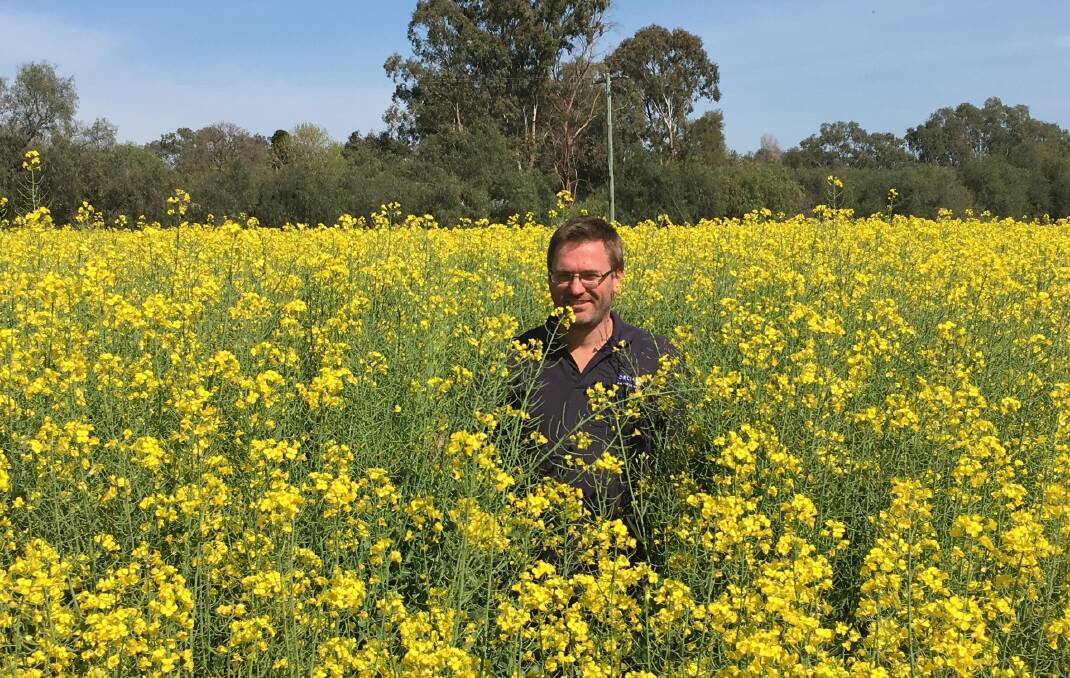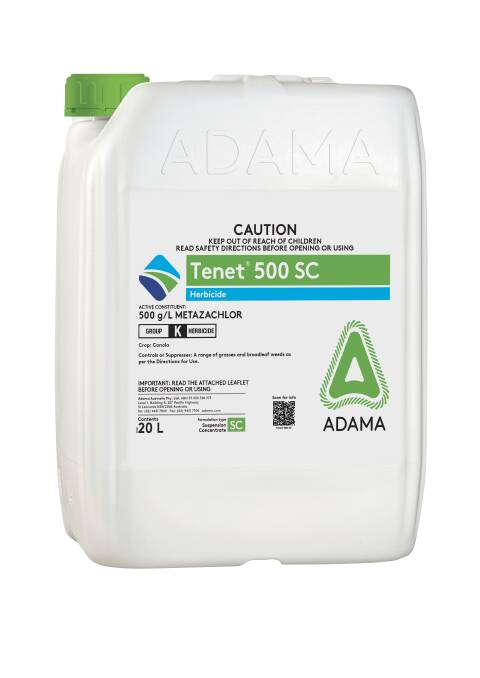Extra canola weed control tools now easing concerns

This is branded content for ADAMA Australia
NEW herbicide options are expanding the weed control toolbox for canola growers, helping to alleviate some of the concern over herbicide resistance and the ongoing use of some popular options, as well as crop safety.
Weed resistance to clethodim and glyphosate herbicides is an issue in various regions, while applications of traditional options such as propyzamide, including in tank mixes, can retard crop establishment.
However, the arrival of Tenet® herbicide and its registration for post-emergent use has opened the door for new, more effective weed control strategies that also are taking the pressure off traditional herbicides and allowing crops to flourish.
In the mixed farming region of North Central Victoria, Nutrien Elmore Agronomist Chris Dunn said problems controlling wild radish in the past, plus weed resistance to glyphosate, meant most of the canola production through the area was devoted to triazine-tolerant (TT) varieties.
He said clethodim had been another important herbicide in these cropping programs, however up until the ability to tank mix with Tenet for post-emergent application, there also have been concerns over its longevity.
"We have started to see clethodim resistance, so we needed to look at how we can take the pressure off it and keep it around because it is such an important herbicide. We would look at anything to help extend its life," Mr Dunn said.
He said the ability to use Tenet post-emergent now allowed growers to separate the use of clethodim from triazine applications and apply it with the residual herbicide, which also was helping to achieve better results.
"Growers might now go upfront with trifluralin and bixlozone, trifluralin with propyzamide or trifluralin by itself, come back PSPE (post-sowing, pre-emergent) with atrazine and terbuthylazine, and then in the early post-emergent window, depending on the ryegrass pressure, apply clethodim with Tenet," Mr Dunn said.
"Going post-emergent with Tenet has really helped and we have had the benefit of good moisture conditions afterwards to assist herbicide activity."
Developed by ADAMA Australia, Tenet contains the active ingredient, metazachlor, and is the only Group 15 herbicide that can be applied post-emergent or incorporated by sowing (IBS) in conventional and herbicide-tolerant canola.
Mr Dunn said he initially had the opportunity to view Tenet's performance at ADAMA Australia's large, "learning centre" trial site in the region, as well as at Nutrien's own trial site in the area.
"The Tenet and clethodim is a good fit to help with control and it provides good residual to then allow crop competition over the top, helping limit late ryegrass by having a thick canopy," he said.
"We also noticed no crop effects with Tenet and clethodim, whereas you do get effects with propyzamide. Tenet is definitely softer than propyzamide.
"Before we could apply Tenet post-emergent, we played around with applying propyzamide with clethodim, but it hurt the crop a bit."
He said in addition to the extra herbicide options now available, other weed control options also were being explored, including weed seedset reduction at harvest.
It has been a similar story in another mixed farming area further north, around Coolamon in Southern New South Wales, with escalating weed resistance to clethodim posing grass control challenges in the TT canola predominantly grown through the region.
Glenn Dyason, Senior Agronomist with Delta Agribusiness at Coolamon, said Tenet would now continue to play a key role for weed control in canola following its post-emergent registration.
"Growers have traditionally applied trifluralin with atrazine pre-sowing, and now they can use Tenet with post-emergent top-up applications of atrazine," Mr Dyason said.
"We like clethodim to be applied early, followed by atrazine with Tenet soon after.
"We're not convinced of any antagonism, but we like to split Tenet from clethodim to ensure clethodim achieves the best results possible."
He said earlier post-emergent trials featuring Tenet achieved excellent results and this also had been reflected in growers' paddocks.
"We are pretty happy with the results from Tenet and it is helping clethodim out quite a bit, particularly in high weed pressure paddocks."
"There's definitely a place for it in the canola phase. The weed control is easily getting through to stem elongation or full canopy closure."
Mr Dyason said crop-topping also was carried out where necessary later, while mechanical weed control methods including harvest weed seed destruction and windrow burning were employed as well.

Alistair Crawford, Market Development Manager with ADAMA Australia in Victoria, confirmed that with clethodim activity starting to fail in areas, Tenet was proving to be an excellent residual option with post-emergent knockdown herbicides.
"We had Tenet with clethodim in a trial where there was some resistance to clethodim and glyphosate at the site and it did quite well. It took the control from about 40-50 per cent up to about 80 per cent," Mr Crawford said.
"Uptake of Tenet in canola is increasing. There aren't too many options in the post-emergent window and following its registration for this use pattern, 60-70 per cent use of Tenet is now post-emergent.
"It's taken up mostly through the roots and you can mix it with pretty much anything post-emergent in canola - glyphosate, Liberty®, clethodim and imidazolinone, and add oils too - and it doesn't increase crop damage from other herbicides in the mix.
"It's ideally applied early, on young ryegrass, and always in a mix, helping to improve the knockdown and provide residual control."
He said in southern areas, many growers wanted to use Tenet post-emergent because other options were limited and they wanted to avoid damaging crops, whilst they also were using different mode of action herbicides pre-emergent.
In northern areas, where there can be drier soils and reduced ryegrass pressure, some growers also were achieving good results from applying Tenet pre-emergent, and mixing it at lower rates with propyzamide or trifluralin.
"Propyzamide and trifluralin are immobile in the soil, whereas Tenet is more mobile, so, also in mixes, Tenet can help the immobile herbicides and provide better weed control, particularly in the furrow after the herbicides have been thrown out of the furrow," Mr Crawford said.
"It can be good to use a low rate of Tenet pre-emergent in mixes with other modes of action, where it works well on ryegrass, and then growers can apply their normal clethodim, triazine or 'imi' herbicides post-emergent, depending on their system."
Growers interested in further information about Tenet herbicide can contact their local reseller or ADAMA Australia Commercial Manager.
Growers interested in further information about Tenet herbicide can contact their local reseller, ADAMA Australia Commercial Manager or visit www.adama.com/australia/en/crop-protection/herbicides/tenet
This is branded content for ADAMA Australia


